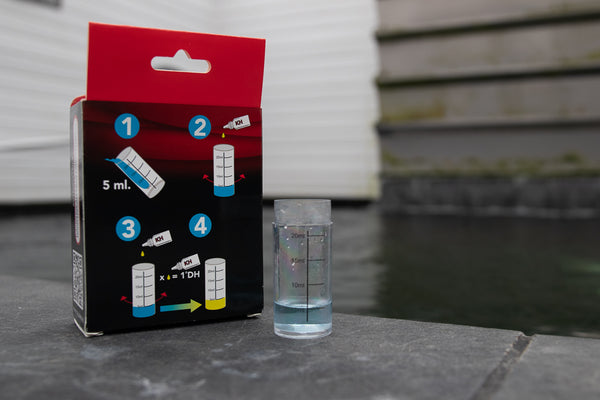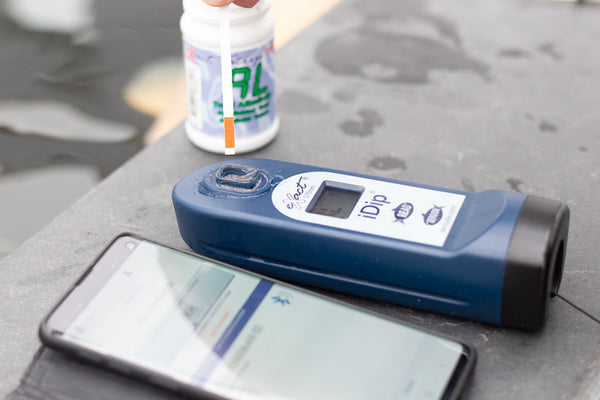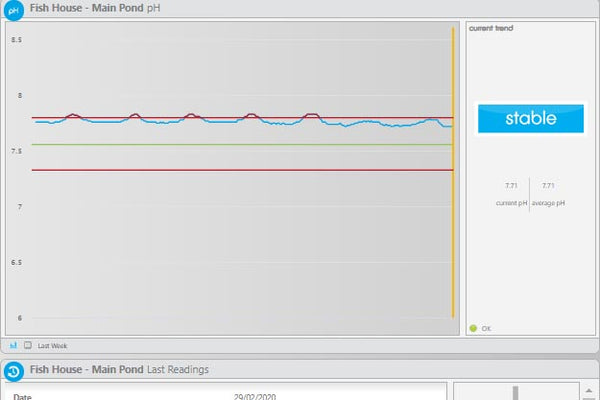Your Cart is Empty
by Chris Thomas April 08, 2020 5 min read

KH, or Carbonate Hardness can be considered the most important water parameter that needs to be monitored and controlled by koi keepers. Without proper KH level, there is no bio filter, and left unchecked can lead to a pH crash. Without swift, corrective action, this can be fatal for your koi. Understanding KH and it's importance can prevent this ever happening. In this blog post we will explain what KH is, why it is important, and what you can do as a koi keeper to control KH for healthy koi.
KH derives from the German Karbonathärte and it is a measure of the carbonate hardness of water. The unit dKH (degrees of carbonate hardness) is most frequently used by test kits aimed at koi keepers and aquarium keepers. Carbonate hardness is the presence of carbonate and bicarbonate anions in water. Carbonate hardness is also referred to as 'temporary hardness', and having a low dKH means you have 'soft' water, and a high dKH would mean you have 'hard' water.
1dKH is the equivalent of 17.8 mg/l (ppm) of CaCO3 - test kits will use one of the units here, or both such as the eXact iDip.
KH, or carbonate hardness is important because it underpins the entire stability of the koi pond environment. The carbonates dissolve in to the pond water to act as a buffer to changes in pH. If the carbonate hardness is depleted, the pH of the pond will crash. This is such a serious issue that it could and has in other cases, lead to complete loss of life within a pond. The biggest contributor to acidity of the water in a koi pond is carbon dioxide.
Carbon dioxide is produced by fish respiration, photosynthesis, and decomposition of waste. It’s fair to say that the higher the stocking rate, the more important it is that an adequate level of carbonate hardness is maintained.
Carbonate hardness is ‘consumed’ by the buffering process, so it is necessary to replenish carbonates in the pond environment. This can be achieved by regular water changes (10-20% per week) or by adding bicarbonate of soda, or other off-the-shelf KH buffers. By testing for carbonate hardness using a KH Test kit with your routine water testing, you can decide if water changes are replenishing sufficient carbonates, or if you need to add a buffer.
As well as being consumed by the production of carbon dioxide, the carbonate hardness is used by the filter bacteria. It takes approximately 7mg of carbonate hardness to process 1mg of ammonia to nitrite – again, heavy loading of the pond leads to a higher carbonate demand on the system, and will require more frequent testing and correction of the carbonate hardness.
Mains tap water contains a variable amount of carbonate harness so should be tested regularly. We often have people coming to us for help after a pH crash, and often root cause is a change in tap water supply conditions. If you have an undetectable dKH from your tap water then you must add a regular buffer.
It’s worth noting here that rain water is always very ‘soft’ and contains little to no carbonate hardness. Using rain water to top up a pond is not advised for this reason. Also, after a period of heavy rain, it is not unusual for KH levels to be lower. If you do often have a low KH, then testing and correction after heavy rain would be advisable.
Knowing the KH, or the buffering capacity of you pond water can be critical when using some treatments. Some chemicals are more toxic at lower pH (Chloramine T, Colombo Alparex, for example), in some cases the dose rate must be adjusted or the KH level needs to be increased.
For most koi keepers, that do not want to spend their life worrying about water chemistry, the ideal KH of a koi pond will be around 5-8dKH or 89-142ml/l. I am not saying this is the BEST KH for a koi, but it is best for most koi keepers as it provides the pH stability that koi need. The pH should not change more than 0.2 in 24 hours.
If your KH is lower than 5dKH or 89mg/l, then you will want to add a buffer to your pond. If you KH is higher than this, there is normally no need to try and correct it.
There are two popular methods for testing carbonate hardness available to koi keepers. One is a liquid drop test kit, available from a number of manufacturers such as Colombo, Kusuri, and NT Labs. The second is the use of a photometer (such as the eXact iDip), which uses the measure of light transmitted through a sample and reagent. The KH should be tested every week along with your other water tests, and it would be wise to also test your incoming tap water if you rely on tap water for keeping your KH levels topped up.

The liquid drop test kits usually work by adding drops of a reagent to the sample until the sample changes colour. The number of drops translates to the dKH of the sample.

When using a photometer, a reagent is added to the sample, and the light that passes through the sample is measured by the device. From the amount of light measured and preloaded algorithms, the dKH or mg/l will be displayed.
A third method which we have found to be very useful is the use of a Seneye. Whilst it does not directly measure KH, or even calculate it, the graph function of the pH reading serves as an indicator of a drop in KH levels. Using the mobile app, the pH reading will display a trend icon. If the app is showing a trend of falling pH, then you know it is time to test your KH and add a buffer. The website graph will show more detail - as the KH levels fall, the pH change throughout the day will increase, and the average pH will fall. 
Here you can clearly see the natural rise and fall of pH during the day due to photosynthesis in the algae and increased respiration from active fish. A higher level of KH will minimise this swing, which should be kept under 0.2 per day - the scale of these graphs look quite drastic but the graph labelled Fish House has an average difference of 0.13 between highest and lowest. You can see the larger changes are from addition of carbonates, and the gradual fall over time between doses. Again, the scale of the graph makes this change more dramatic than it is.
Hopefully you have a better understanding of carbonate hardness and it’s importance to water chemistry in a koi pond. Many people experienced in keeping koi will say ‘we don’t keep koi, we keep water’, or some variation of. By monitoring and replenishing KH when required, you will maintain a stable pH and provide plenty of carbonates for adequate bio filtration.
We stock a full range of KH tests kits, starting with economical options such as liquid drop tests from Colombo, Kusuri, and NT Labs, as well as the eXact iDip multi parameter photometer, the Hanna Alkalinity Pocket Checker, and the Hanna 83303K Aquaculture Benchmeter. We also stock KH buffers should you require. It’s always advisable to dechlorinate water before adding it to your koi pond – in our online store you will also find liquid dechlorinators and inline water purifiers.
Chris has been keeping koi for over 25 years, and dealing in koi for 15 years. Travelling to Japan to select new stocks is the favourite aspect of the business, closely followed by being on the tools pond building.
Comments will be approved before showing up.